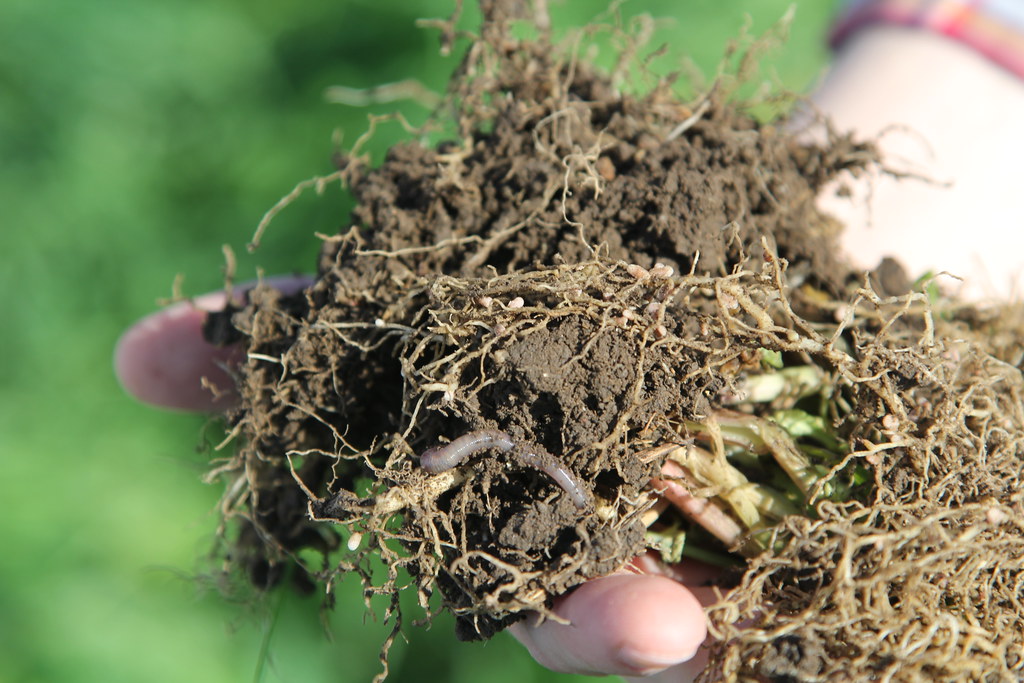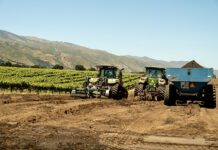
Mention “soil health” to a grower and they may recognize its value but may not understand exactly what it is or how to get there. Mention soil health to a soil scientist and you’ll likely get an hour lecture on how it needs to be done. Soil health, or regenerative agriculture, is a growing priority, and its central tenet is a soil that is robust, resilient and capable of performing desired ecosystem functions such as nutrient cycling and sustaining plant health. The components of a healthy soil include biota, organic matter, porosity and aeration, and a balanced chemistry.
Soil 101 says that soil is composed of inorganic minerals in the form of sand, silt and clay. It also includes microorganisms and organic materials in the form of humus and decomposing matter. The combination of these components creates the soil structure. In addition, soil pore space comprises half of the total soil volume through which water and air move into and out of the soil. The fraction of pore space is a critical factor regulating soil health. The soil pore network governs the rate of water infiltration and air exchanges with the atmosphere.
Components of Soil Health
The percentage of each of these components within a soil is what determines the type, texture, productivity, and many of the characteristics of soil health. A healthy soil has a pH between 6 to 7.5, adequate cation exchange capacity with a proper balance of basic cations (e.g., calcium, potassium, magnesium), relatively low salinity, an appropriate balance of plant nutrients in both organic and inorganic forms, a pore distribution that ensures adequate infiltration rates and water retention for crop production, and organic matter and associated microbial communities that buffer and sustain plant nutrient requirements.
West Hills College Coalinga (WHCC) Farm of the Future (FoF) has made healthy soils a focus because of its importance to productivity and soil and water conservation. Fundamental concepts are taught in several courses: Introduction to Soil Science, Soil Amendments, Orchard Production and Plant Science. To support this instruction, FoF is looking for partners to demonstrate to our students, products or practices that improve soil health using demonstration research projects. These projects teach students about research methods and new technology. WHCC is in an excellent position, as a college known for hands-on learning, to serve as an unbiased third party for evaluating new products and the practical side of research.
Recently, WHCC had the opportunity to test a new soil amendment product that is promoted to enhance nutrient and water use efficiencies. Field trials suggest the product duplicates the effect that organic matter has on soil structure, water retention and supporting soil microorganisms. It can be described as a nano-granule polymer that is inoculated with Mycorrhizae and has a CEC value five times greater than peat moss. The product, called Zytonic, is produced by a company called Zydex. Zydex was interested in demonstrating the impact Zytonic can have on soil health to students and approached WHCC about doing a demonstration project.
Organic Matter
Organic matter as a carbon-based material has the ability to bind soil particles together to create aggregates, altering the soil structure and soil pore networks. As a result, soils with higher organic matter feel “fluffy” or “softer”.
One problem with maintaining healthy soils in the California Central Valley is maintaining organic matter. In the Midwest, summer rains, cooler temperatures and higher humidity are conducive to maintaining organic matter. When land in the Midwest is fallowed, cover crops grow naturally. In the Central Valley, cover crops require irrigation and higher levels of management. Fallowed land typically is managed as bare ground by regular disking to control weeds; the net effect burns away any organic matter that is present. To reverse this trend, fallow practices that provide organic residues and sustain moisture levels are required. With water restrictions, such practices are especially challenging in annual crops while perhaps more feasible in permanent cropping systems.
Organic matter impacts other soil components, and its loss results in a cyclic pattern. Application of inorganic fertilizers reduces the ability of a plant to absorb organic sources of nutrients which results in mineralizing organic matter. The loss of organic matter on the top layer of soil reduces cohesiveness which increases wind and water erosion and compaction. Compaction reduces the ability of microorganisms to grow, which in turn reduces the ability to decompose fresh organic matter. This lowers the nutrients available and requires an increase in use of inorganic fertilizer.
Inorganic soil particles impact the cohesion of water molecules to soil particles. Water Holding Capacity (WHC) is an indicator for retention of water (high WHC) or infiltration (low WHC). A soil that has an extremely high WHC due to soil texture not only retains water in the soil, but may retain it so “tight” that it is unavailable to the plant. In soil with low WHC, water infiltrates or flows through the soil, taking nutrients with it (leaching). This also leaves less water available for the plant, resulting in roots “fighting” soil particles for the water. The goal is to have a soil structure that retains water not only for the plant roots but also for the microorganisms within the soil.
In our Zytonic test, a one-acre plot was laid out by WHCC students into six rectangular blocks, each of which were divided in half. For each of the six blocks, halves were randomly assigned to a treatment or control plot. Students from Introduction to Plant Science hand-planted 3000 broccoli plants in the field. Students assigned to the project, assisted by Dr. Tim Ellsworth, applied pre-emergent herbicide and manually weeded the plots. Soil Amendments and Fertilizers students mixed and applied the Zytonic to the treatment plots in a water solution. Plants were watered using the FoF sprinkler system uniformly over all blocks and plots.
Row Crop Production students assisted in the plot, though the COVID-19 pandemic developed during the study. By the time the broccoli was ready for harvest, the home sheltering directive was in place and staff completed the harvest and data collection.
For this initial research demonstration, the weight of the product was the key indicator. Sixty random sample plants were pulled with roots from each block plot and weighed for an aggregate. Thirty random plants were then selected for individual weights for each plot. Nick Trujillo, FoF Research Analyst, helped to complete harvest, data collection and analysis of the data.
The most meaningful advanced statistic would be a t-test, which shows if there is a significant statistical difference. A Welch t-test p-value of 0.028, which is below the 0.05 value, means there is a statistically significant difference between the weights in descriptive stats above and that the Zytonic broccoli weighed more.
An unexpected outcome was the growth of root hairs. Though it was not a part of this study, as staff were pulling the broccoli from the ground, it was consistently more difficult pulling them from the treatment plots. On investigation, the amount of root hairs from the treatment group was much more developed than the broccoli from control plots. It was theorized that the pore space allows for the advanced growth of root hairs in the row crop and may translate to lateral roots in permanent crops.
Though this demonstration was completed on a row crop, the next demonstration project being discussed is applying the Zytonic through the drip system on the FoF Pistachio Orchard. Orchard Production, a new course on the schedule for the first time in Spring 2021, will likely use Zytonic in the establishment procedure for pistachios or almonds that will be planted as part of class lab exercises to determine long-term effects.
The results from this one demonstration doesn’t prove that the use of polymer-based nano-granules help with increased growth, but fundamental concepts of soil science support it. Having a soil that has a higher percent of pore space and availability of water will likely absorb water and nutrients at a higher rate. Looking toward the next demonstration with Zydex, it will likely focus on extended availability of water due to higher retention with Zytonic. In other words, testing to see if water applied in an 8-hour set will stay in the root zone for a longer period of time, allowing trees to get the water they need with less total water applied in lesser numbers of sets.
No final conclusions on the effectiveness of Zytonic can be made from this one small demonstration, but from an educational point of view, it was extremely valuable for WHCC FoF students.















